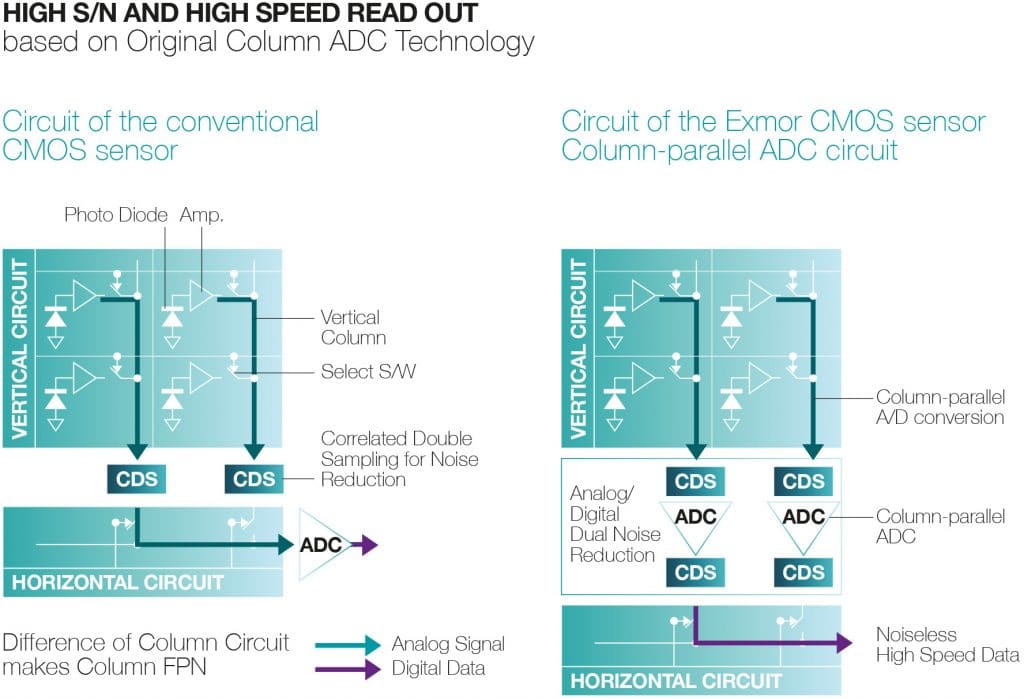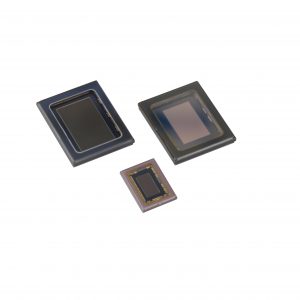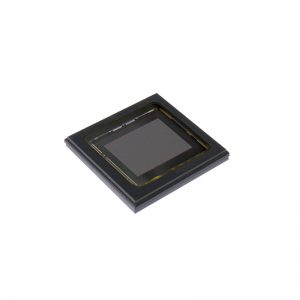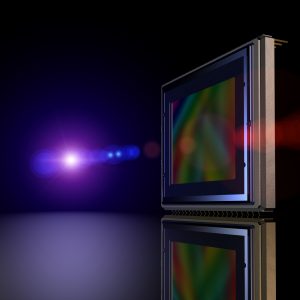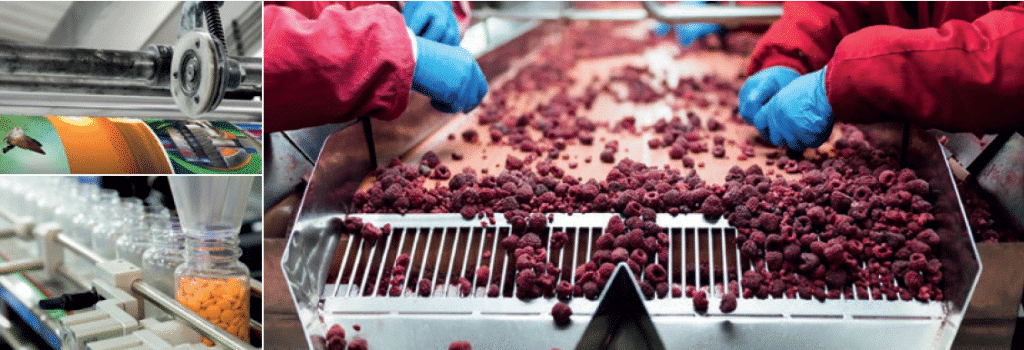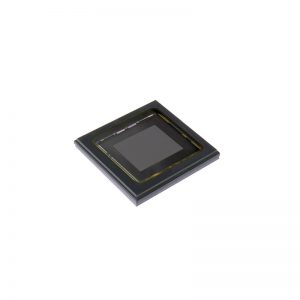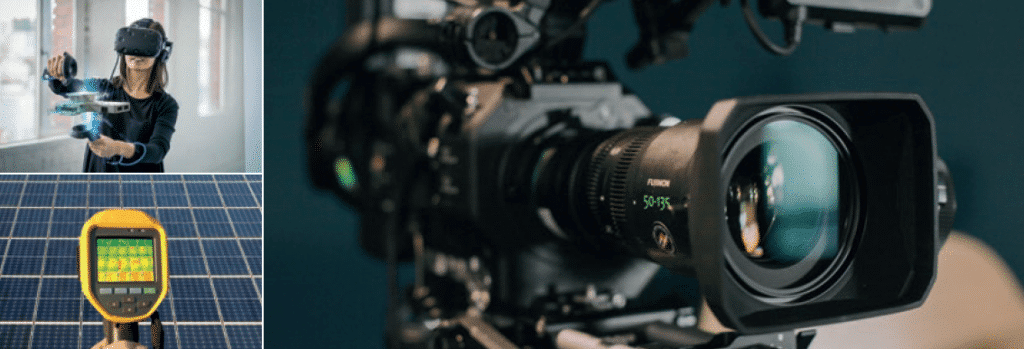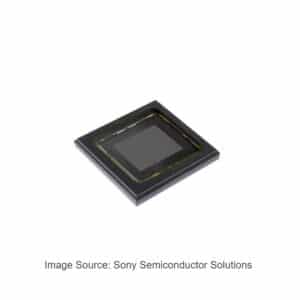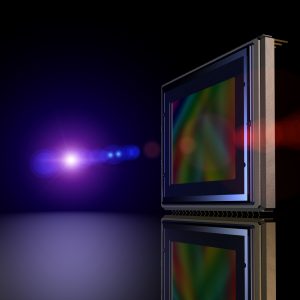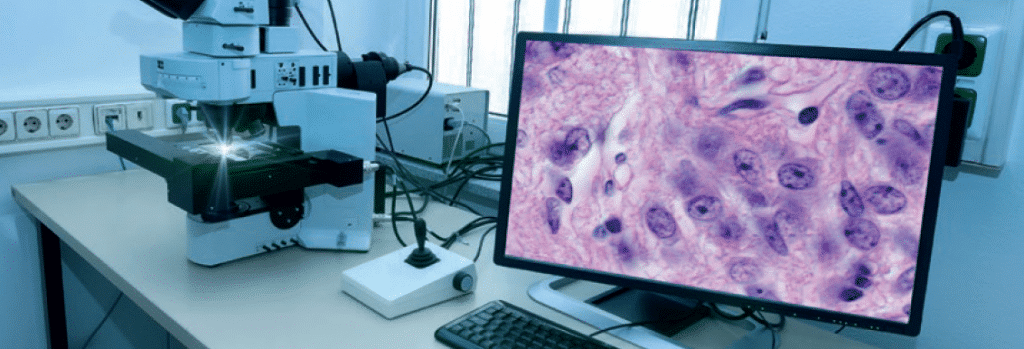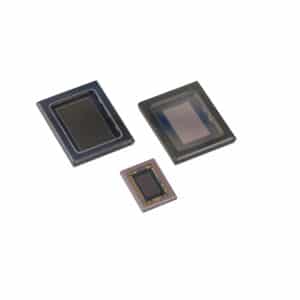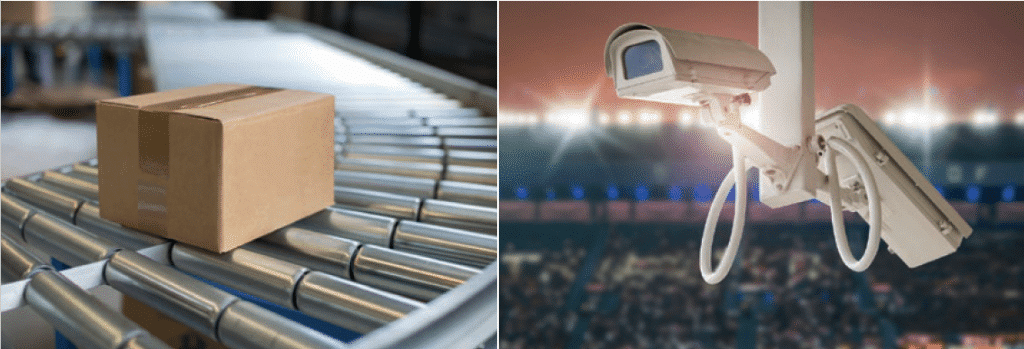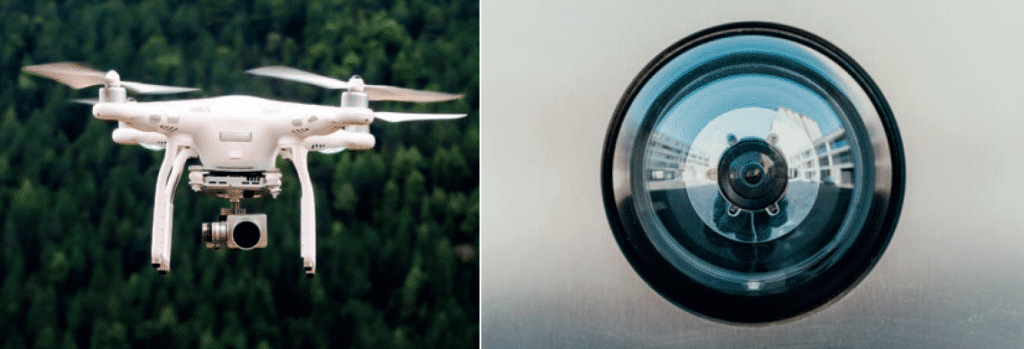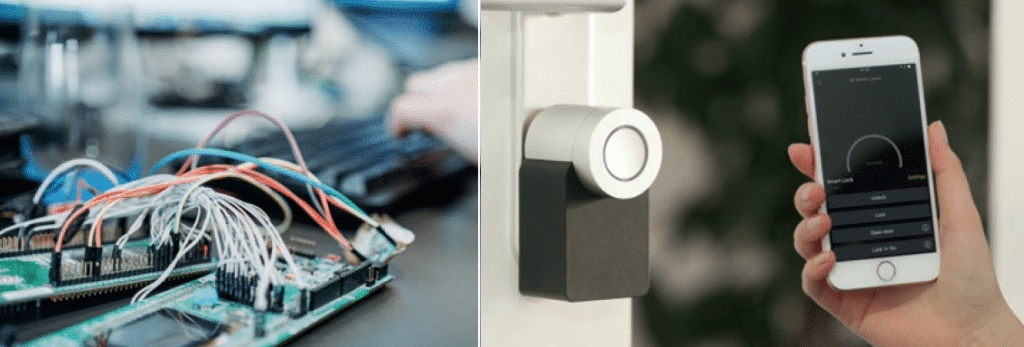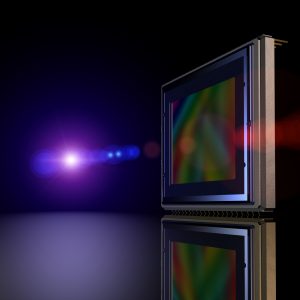SONY PREGIUS TECHNOLOGY - CMOS GLOBAL SHUTTER
The State of Art in Machine Vision Image Sensors
Introduction to the SONY® Pregius™ Series
THE LAUNCH OF THE SONY'S PREGIUS TECHNOLOGY SERIES IN LATE 2013 MARKED A MILESTONE IN THE HISTORY OF IMAGE SENSORS.
Its outstanding performance, success, and large consumer capacity were among some of the triggers resulting in Sony’s decision to shut down their CCD sensor development and production, despite their technology and market leadership. The Pregius technology series combines the image quality from its technology with high readout speeds, an electronic global shutter and the low noise EXview HAD II Technology from the CCD designs.
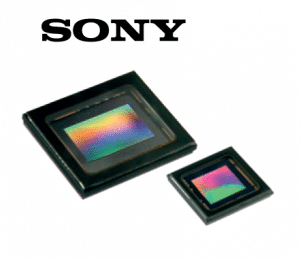
Thanks to latest advances in wafer production techniques and pixel design, today’s professional grade CMOS image sensors outperform CCD’s in both speed and image quality. They are now also capable to start and stop the light exposure time for all pixels simultaneously, (known as global shutter). CMOS sensor technology has continued to evolve with unprecedented advances in resolution, frame rate, sensitivity, readout-noise, high dynamic range, and control features that enable new applications in industrial imaging.
Pregius and Pregius S are the registered trademarks of Sony Group Corporation or its affiliates.
Pregius Technology
Pregius is a global shutter pixel technology based on Sony’s low-noise CCD structure. Active pixel CMOS image sensors used in these products produce highquality images.
This technology was named Pregius to represent the combination of the low-noise performance of CCD with the high-speed and high-precision performance (Precision GS) of global shutter (GS) required by FA applications.
One of the building blocks of the technology is the digitization of the pixel data early in the transfer process. This minimizes the amount of additional noise that is accumulated as the image data travels around within the sensor, even at high speed. To further improve the noise response of the sensor, correlated double sampling (CDS), a technique borrowed from CCD design, is implemented on either side of the ADC (analog to digital conversion) and cancels out the noise in the signals, ensuring the accuracy of the digitized data.
These sensors now feature a pixel architecture with high quantum efficiency (QE), known as the conversion ratio of arriving photons into electron charges captured within the pixel’s photosensitive area. Greater QE leads to a stronger electric signal and thus to better sensitivity.
Pixels within Pregius technology sensors have an
increased well depth, enabling them to capture and hold more electrons before saturating. This provides higher dynamic range of achievable pixel values, when combined with ADCs with more digitization bits, while also increasing its sensitivity to longer NIR (near infrared) wavelengths.
Sony has optimized the technology over many years and product generations. It features unrivaled image quality, even at very short exposure times or under diminished lighting conditions.
Sony's Pregius Technology Portfolio
Download our latest Sony Pregius Brochure to get a detailled overview and full insights of the Pregius Technology Portfolio.
Sony's Global Shutter CMOS Generation
The Sony’s Pregius technology series of Global Shutter CMOS sensors has evolved over several product generations. Each one features similar pixel architectures and readout circuits. Individual improvements were introduced with each new generation but so did some trade-offs between pixel size, saturation capacity, and sensor size. Therefore, specific application requirements will determine the best generation to use.
With its second generation, Sony responded to the requests from the machine vision market. These sensors provide an 8-bit ADC option, in addition to the 10 and 12-bit ADC options previously offered, reducing the minimum output bit depth while increasing output framerates. To further increase image outputs, Sony doubled the number of data channels offered by the first-generation sensors to 16 lanes, increasing their overall output bitrates to 9.5 Gbps. Extended functionalities, like additional trigger and operating modes, enable and simplify many imaging solutions. The smaller 3.45 μm pixel size does limits the saturation but, with its lower readout noise of 1e-, still enables an impressively high 73.6 dB of dynamic range.
Furthermore, thanks to this pixel size, the first sensor of this generation, the IMX250 with 5.07 MP and 2/3″ optical format, is a direct replacement for Sony’s ICX625 and ICX655, its CCD antecessors. Thus, a large variety of optics are immediately available for cameras with the new Pregius technology sensors which can serve as drop-in replacement for previous CCD-based systems.
Some of the innovations that the third generation demonstrate great improvements, mainly in terms of image quality, speed, and features. Applications looking at moving objects or cameras that are subjected to movement or shaking, such as those running production lines, robotics applications, or ITS, and automotive sectors benefit from these advancements.
The larger 4.5 μm pixel size creates a much higher full well capacity which is complemented by a low 1e- readout noise, giving a maximum dynamic range of 76 dB* (Dual ADC mode). These characteristics allow for detection of objects in difficult lighting conditions with only one captured image. Similar to the second-generation sensors, there are variants that combine 2×2 pixels providing 9 µm pixel sized sensors. These large pixel sizes enable a high full well capacity giving a 76 dB* (Dual ADC mode) dynamic range that is ideal for detailed snapshots of high-contrast scenes.
The increased bandwidth of these sensors requires an interface faster than existing LVDS and MIPI standards can support. As such, Sony has developed the SLVS-EC standard to overcome these limitations, streaming data at 19 Gbps across 8 channels, doubling the maximum throughput of second-generation devices. These sensors are perfectly suited for cameras leveraging high speed data interfaces like USB 3.2 Gen 2 and 2×2, 10-50 GigE, or CoaXPress.
Besides improved imaging performance, the third generation sensors come with a host of new helpful functions designed to enable more simple and powerful vision systems.
The latest, fourth generation, Sony’s technology continues to further demonstrate technical advancements. The pixel architecture of these sensors has been shrunk and completely redesigned. The new Pregius S technology series now offers high resolutions, up to 25 megapixels, with a 1.2” optical format, making them suitable for standard C-mount lenses in small camera body sizes.
These new sensors, supporting different resolutions, are included in the introduction of this generation. Thanks to their backside illuminated pixel architecture and global shutter, Sony managed to reduce the pixel size to 2.74 µm while maintaining or improving the previous series’ performance features.
These improvements result in better color reproduction, especially in the blue spectrum band. The new pixels allow for smaller chief ray angles, thus making them more robust against unwanted lens shading effects. The pixel output data rate was doubled from its predecessor which aligns well with the newer, high speed, data interfaces common in machine vision like 10-50 GigE or CoaXPress. The cost-effective, slower variants fit well in cameras using USB3, 5 GigE, single-lane CoaXPress or Camera Link. Once again, a square sensor is included in this portfolio making it perfect for high-resolution microscopy and inspection tasks.
1st Generation | 2nd Generation | 3rd Generation | 4th Generation | |
|---|---|---|---|---|
Pixel size (µm) | 5.86 | 3.45 / 6.9 | 4.5 / 9 | 2.74 |
Frame Rate | 2.4M 10 bit 164 fps | 5.1M 10 bit 144 fps | 7.1M 10 bit 170 fps | 8.1M 10 bit 192 fps |
Interface | Sub-LVDS | Sub-LVDS SLVS-EC (2.5G) MIPI | SLVS SLVS-EC (2.5G) | SLVS SLVS-EC (5G) MIPI |
Bit depth | 10/12 | 8/10/12 | 8/10/12 | 8/10/12 |
Max. output (Gbps) | 4.7 | 9.5 | 19.0 | 38 |
Unique Requirements Call for Unique Sensors
All Sony sensors in a Pregius technology generation share similar pixel architectures so they supply comparable imag quality. As some applications are less dependent on speed and control features, the Sony’s Pregius technology Series offers sensor variants with reduced frame rates and feature sets. Leading-edge machine vision applications require high speed, fully featured sensors with ITS and traffic, and standard machine vision can settle for a lower cost, lowspeed variant with reduced feature set. Some global shutter modules are designed specifically for video recording that has unique features needed for high-end video captures in areas of research, monitoring, or broadcasting.
Toggle Title
High-Speed Applications
These flagship sensors combine the outstanding image quality, innovative pixel architectures and advanced readout circuitry with leading edge data interface protocol and cutting-edge features
- Analog-digital conversion with 8, 10, or 12 bit
- Exposure time control: external trigger pulses can define light accumulation times
- Trigger output: signals indicating sensor status during shutter operation for synchronization with peripheral circuitry
- Fast trigger mode: reduced delay between trigger and exposure
- Multi-exposure mode: single trigger pulses initiate a sequence of image captures
- Sequencer: Series of 2/4 frames can be captured after single trigger, with user selectable exposure time, gain, and ROIs for each frame in the sequence.
- Regions of Interest: Field of view of the sensors can be cropped into 16 / 64 overlapping regions of interest.
AVAILABLE MODELS | |
|---|---|
IMX287 | 0.4 MP |
IMX426 | 0.51 MP |
IMX273 | 1.6 MP |
IMX425 | 1.78 MP |
IMX422 | 2.03 MP |
IMX174 | 2.32 MP |
IMX392 | 2.35 MP |
IMX421 | 2.86 MP |
IMX252 | 3.19 MP |
IMX250 | 5.07 MP |
IMX537 | 5.1 MP |
IMX420 | 7.1 MP |
IMX536 | 8.1 MP |
IMX255 | 8.95 MP |
IMX253 | 12.37 MP |
IMX535 | 12.4 MP |
IMX532 | 16.19 MP |
IMX387 | 16.88 MP |
IMX367 | 19.66 MP |
IMX531 | 20.35 MP |
IMX530 | 24.55 MP |
IMX342 | 31.49 MP |
Low-Speed Applications
Applications looking for reduced speed and features sets can benefit from these costeffective models, without sacrificing image quality
- Analog-digital conversion at 12 bit
- Regions of Interest: 1
- Sequencer with 2 / 4 frames with different exposure times and gains
- Trigger modes: fast, self, dual
AVAILABLE MODELS | |
|---|---|
IMX433 | 0.51 MP |
IMX432 | 1.78 MP |
IMX430 | 2.03 MP |
IMX249 | 2.35 MP |
IMX429 | 2.86 MP |
IMX265 | 3.19 MP |
IMX264 | 5.07 MP |
IMX548 | 5.1 MP |
IMX547 | 5.1 MP |
IMX428 | 7.01 MP |
IMX546 | 8.1 MP |
IMX267 | 8.95 MP |
IMX304 | 12.37 MP |
IMX545 | 12.1 MP |
IMX542 | 16.19 MP |
IMX541 | 20.35 MP |
IMX540 | 24.55 MP |
Global Shutter Visualization and Video Recording Applications
To simply record or visualize moving objects, the following sensor models offer their global shutter functionality to obtain blur-free, color only, image captures. Their frame rates match common video standards.
- 2-frame set output mode: Recording of two consecutive frames at different exposure times, externally merged into one picture, for wide dynamic range imaging.
- Regions of Interest: All-pixel scan or Full-HD mode
AVAILABLE MODELS | |
|---|---|
IMX297 | 0.4 MP |
IMX296 | 2.6 MP |
Sensing
Inspection tasks that require only monochromatic images with fixed bit depth per pixel can benefit from the low data rates provided by these sensors, and lower cost, smaller processors. These sensors are key for keeping costs low for small, embedded vision systems.
AVAILABLE MODELS | |
|---|---|
IMX297 | 0.4 MP |
IMX296 | 2.6 MP |
High Resolution Embedded Vision
More IoT and embedded vision-based applications are looking for compact sensor sizes at higher resolutions. These devices need to be connected to embedded processors directly through common interfaces. System designers have standardized on MIPI CSI-2 for their vision data interface. These sensors can be directly connected and controlled by advanced embedded processors for simpler designs and integrations.
AVAILABLE MODELS | |
|---|---|
IMX568 | 5.1 MP |
IMX2567 | 5.1 MP |
IMX566 | 8.1 MP |
IMX565 | 12.4 MP |
Pregius technology generations
1st Generation
2nd Generation
3rd Generation
4th Generation
1ST GENERATION - 2.4 Megapixels
IMX174 / IMX249 / IMX302
The Masterpiece
While the IMX174 was introduced in 2013, it is still a class leading sensor in performance while marking a milestone in Machine Vision history. The IMX174 captures full frame images at 1936 x 1216 resolution, running at 164.5 fps with 10 bits/pixel. In Full-HD, the sensor delivers 180 fps, perfect for slow motion playback. The very large 5.86 μm pixel pitch and 1/1.2″ format provides crisp images. This sensor and its low- peed companion, the IMX249, fulfill the requirements of a large variety of machine vision applications that once used slow megapixel CCDbased sensors.
Its large pixel size and per pixel micro-lenses ensure high quantum efficiencies and a full well capacity of electrons.
The maximum data rate of the IMX174 is at 4,752 Gbps, pairing well with the USB 3.2 data bandwidth. By reducing this sensor’s frame rates by half or a quarter, it can also be targeted for various machine vision applications looking to integrate GigE or dualGigE interfaces. Short bursts at full speed can be buffered internally to the camera which can then be slowly transferred across these slower data interfaces. Running the IMX249 at its maximum frame rate of 30 fps at 12 bit delivers 1,188 Mbps aligns well for continuous recording with Gigabit Ethernet based platforms.
The high sensitivity and large full well capacity combine well to ensure that both light and dark areas are accurately captured within one image. This wide dynamic range is beneficial for application such as fast and precise localization of laser lines in 3D profilometry or for the inspection of shiny surfaces with glare and/or specular surfaces. Traffic applications need to also deal with challenging lighting conditions caused by headlights at night or sun reflections. These sensors deliver high contrasted images need by the applications for vehicle number plate recognition in automatic tolling, car access control or traffic law enforcement.
High-speed | IMX174 |
|---|---|
Low speed | IMX249 |
GS-Video | IMX302 (only color) |
Generation | 1st |
Resolution [MP] | 2.35 |
Horizontal [px] | 1936 |
Vertical [px] | 1216 |
Optical format | 1/1.2 type |
Pixel pitch [µm] | 5.86 |
Frame rate [fps at Bits per Pixel] | 164.5@10 128.2@12 (IMX174) 30@12 (IMX249) 64.1@12 (IMX302) |
Aspect ratio | 16:10 |
Interface | SubLVDS, DDR |
2ND GENERATION - 2.35 Megapixels
IMX392
CCD Replacements
These second generation sensors have the standard 3.45 μm pitch while offering small sensor formats and an optional MIPI interface.
The low-speed IMX297 features at least twice the speed of its CCD predecessors, while the high-speed IMX287 outperforms competing models from other brands in speed, resolution, and outstanding image quality.
With 226 fps in 10-bit mode, the IMX273 allows for highspeed imaging at 1.6 megapixels. The low readout-noise, typical for the 2nd generation, ensures crisp greyscale images as well as accurate color reproduction. Even the low-speed and low-cost IMX296 delivers more than double the frame rate of the widely adopted Sony’s ICX445, 1.25MP, CCD that uses the same optical format. Most lenses designed for this older CCD sensor are suitable for IMX273/IMX296 based cameras.
The IMX297’s maximum bandwidth matches that of a typical GigE interface making it an easy choice for camera designers implementing this interface into their cameras. The IMX287 and IMX296, running at 2.5 Gbps, slightly exceeds the effective bandwidth of GigE and so aligns better to a dual-GigE or NBaseT interface. With its 3.58 Gbps throughput, IMX273 will overpower standard USB 3.0 platforms without some data compression. Camera Link, CoaXPress, or NBaseT at 5 Gpbs would be the interface of choice to leverage the effective throughput of this sensor.
Despite the trend towards higher resolutions, for many applications, like logistics and factory automation, these 0.4 or 1.6 megapixel sensors are still an excellent choice. These sensors fulfill the requirements of applications like presence detection, code reading, geometric measurement, and quality inspection of small areas, at an attractive price.
Thanks to their high frame rates and great image quality at short exposure times, the IMX287 and IMX273 opens up opportunities in new applications as well as in more traditional ones such as production line throughput and imaging of fast moving objects.
High-speed | IMX287 | IMX273 |
|---|---|---|
Sensing | IMX297 | IMX296 |
Generation | 2nd | 2nd |
Resolution [MP] | 0.4 | 1.6 |
Horizontal [px] | 728 | 1456 |
Vertical [px] | 544 | 1088 |
Optical format | 1/2.9 type | 1/2.9 type |
Pixel pitch [µm] | 6.90 | 3.45 |
Frame rate [fps at Bits per Pixel] | 523.5@8 436.9@10 319.9@12 (IMX287) 120.8@10 (IMX297) | 276@8 226.5@10 165.9@12 (IMX273) 60.3@10 (IMX296) |
Aspect ratio | 4:3 | 4:3 |
Interface | SubLVDS, MIPI CSI-2 (IMX297) | SubLVDS, MIPI CSI-2 (IMX296) |
2ND GENERATION - 2.35 Megapixels
IMX392
Making a Great Thing Better
Sony’s first generation sensors offered a great masterpiece of technology, the IMX174 with its incredible pixel performance.
One of the drawbacks for some customers was its large optical format that prevented its use in small cameras and/or with small lenses. It required 1” format optics so lower cost 2/3” lenses could not be used as they would cause vignetting (a.k.a. shading in the corners).
Along came the new IMX392, with its similar resolution and smaller pixel pitch, offering almost identical pixel performance to the IMX174 in a compact package. Smaller cameras can now be built which also benefit from the additional features included in the second generation Pregius technology designs, like the new trigger options and faster readout modes. Its ~8mm optical format couples well with common and less expensive 1/2” lenses.
2ND GENERATION - 3.2 and 5.1 Megapixels
IMX252 / IMX265 / IMX250 / IMX264
The Workhorse Resolutions
The first sensors of the second generation were replacements to popular CCDs, the most common ones being the 5-megapixel IMX250 and IMX264. They feature the same optical format, resolution, and pixel size as the widely used ICX625 and ICX655 CCD sensors. This allows them to leverage the large portfolio of lenses from various manufacturers that were already designed for their equivalent CCD models, leading to lower costs imaging systems. Not only that, but they also offer a whole host of improvements, most notably a huge increase in frame rates. Where the 2-tapped ICX625 barely delivered 15 fps, the IMX250 flies by it, offering up 163 fps with ease. Furthermore, the non-linear and temperature dependent CCD tap balancing has been eliminated making it very simple to integrate the CMOS sensors into new designs and to get great looking images.
Using the same pixel architecture as the IMX250 and IMX264, the 3.19 MP sensors IMX252 and IMX265 address high-speed imaging systems at a lower resolution. With a maximum data rate of 9.504 Gbps (IMX252) and 9.504 Gbps (IMX250), these sensors command high-speed camera interfaces like Camera Link Full, CoaXPress x2, or 10 GigE to maximize their full speed outputs. Not every application needs this output speed so the IMX265 and IMX264 deliver maximum data rates of below 1.8 Gbps, in Full HD-Mode, which fits nicely with cameras using dual-GigE interfaces.
While the full-well capacity is just slightly above 1/3 of its predecessor first generation Pregius technology sensors, the readout noise has been greatly improved, coming in just 1 electron. This low readout noise delivers very clear monochrome pictures and outstanding color reproduction. This amazing image quality is welcomed in applications that analyze color prints, or inspect fruit, vegetables, and pastries in automated food production facilities. Furthermore, demanding applications like panel inspection and surface inspection benefit significantly from higher throughput and accuracy thanks to the speed and resolution of these image sensors.
High-speed | IMX252 | IMX250 | IMX250M Polarized |
|---|---|---|---|
Low speed | IMX265 | IMX264 | IMX264M Polarized |
Generation | 2nd | 2nd | 2nd |
Resolution [MP] | 3.19 | 5.07 | 5.07 |
Horizontal [px] | 2064 | 2464 | 2464 |
Vertical [px] | 1544 | 2056 | 2056 |
Optical format | 1/1.8 type | 2/3 type | 2/3 type |
Pixel pitch [µm] | 3.45 | 3.45 | 3.45 |
Frame rate [fps at Bits per Pixel] | 216.2@8 191.5@10 118.5@12 (IMX252) 55.6@12 (IMX265) | 163.4@8 144.7@10 89.5@12 (IMX250) 35.7@12 (IMX264) | 163.4@8 144.7@10 89.5@12 (IMX250M) 35.7@12 (IMX264M) |
Aspect ratio | 4:3 | 5:4 | 5:4 |
Interface | SubLVDS | SubLVDS, DDR | SubLVDS, DDR |
Want to See More? On-Pixel Polarization Filters!
Polarization is an underutilized property of light and its effect on surfaces and materials was typically managed through external filters in front of the camera. Inspection of objects with transparent packaging or highly reflective surface has been managed primarily by placing polarizing filters externally to the camera thus limiting the incoming light to one polarization angle. This method does not allow the camera to capture light with different angles or under changing conditions.
A variant of the IMX250 and IMX264 are available with additional polarization filters on each of its pixel. These filters transmit light in only one polarization direction. Four different directions are arranged in a 2×2 block of pixels, 45⁰ polarization angle between each one. Hence, each captured image includes 4 different images. With external processing, the degree and direction of polarization of the incoming light can be calculated or defects on complexly shaped and/or reflecting surfaces can be recognized irrespective of the speckles appearing in just one or two polarization angles.
2ND GENERATION - 8.9 and 12.3 Megapixels
IMX255 / IMX267 / IMX305 / IMX253 / IMX304
Ready for the Show
Like all members of the second Pregius technology generation, the IMX253 and its little brother IMX255 are based on small 3.45 μm pixels. They offer 1.1″ and 1″ optical format, and 12.37 and 8.95 megapixel options, respectively. Their large image format and resolution are still compatible with most C-mount lenses.
With a maximum data rate exceeding 9.5 Gbps, interfaces like 10 GigE or USB 3.1 Gen2 are ideally partnered. But higher bandwidth solutions such as Camera Link Deca, CoaXPress v1 x2, CoaXPress v2 x1 or other data interfaces capable of higher bandwidth are also commonly selected during camera designs.
The 1.1″ IMX253, with a traditional 4:3 aspect ratio, is designed for high-resolution analysis of displays or solar panels or built into multi-camera 3D model creation systems for Virtual Reality. This sensor is also available with on-chip polarized pixels. The combination of high resolution and 4 angle polarization images enable highly complex imaging tasks. With corresponding processing, a camera can offer color information, angle and degree of polarization, and light intensity all at once. More information about Sony’s on-pixel polarization filters can be found further up on this page.
The IMX255 features the same horizontal pixel count but has fewer vertical lines when compared against the IMX253. Providing a 17:9 aspect ratio, the IMX255 is suitable for broadcast applications targeting the popular 4K HD (a.k.a. Ultra HD) resolution.
The low readout noise of both sensors contributes to crisp and clear images for reliable 3D captures, color rendition and accuracy, and inspection tasks.
High-speed | IMX255 | IMX253 | IMX253M Polarized |
|---|---|---|---|
Low speed | IMX267 | IMX304 | |
GS-Video | IMX305 | ||
Generation | 2nd | 2nd | 2nd |
Resolution [MP] | 8.95 | 12.37 | 12.37 |
Horizontal [px] | 4112 | 4112 | 4112 |
Vertical [px] | 2176 | 3008 | 3008 |
Optical format | 1 type | 1.1 type | 1.1 type |
Pixel pitch [µm] | 3.45 | 3.45 | 3.45 |
Frame rate [fps at Bits per Pixel] | 93.7@8 88.7@10 63.7@12 (IMX255) 32.2@12 (IMX267) 63.7@12 (IMX305) | 68.3@8 64.6@10 46.4@12 (IMX253) 23.4@12 (IMX304) | 68.3@8 64.6@10 46.4@12 |
Aspect ratio | 17:9 | 4:3 | 4:3 |
Interface | SubLVDS | SubLVDS, DDR | SubLVDS, DDR |
2ND GENERATION - 16.88, 19.66 and 31.49 Megapixels
IMX387 / IMX367 / IMX342
See it All
Rounding out the list of second-generation sensors is a few large resolution ones with larger optical formats. The IMX342, at nearly 32 megapixels, is designed for applications where high resolution is key, such as electronics and semiconductor panel inspection, where the goal is to recognize fine details over large areas with speed and with fewest images as possible. The large number of pixels enables digital pan or zoom on demand. Cameras with the IMX367 can run up to 43 fps while those with the IMX342 can do 35.4 fps. Both are perfectly suited to replace existing implementations based on slower 29 megapixel CCD sensors.
The smaller IMX387 and IMX367, with their 16.88 and 19.66 megapixels, respectively, have a 4/3” format that fits into C-mount camera designs. They are ideal when more than 5 megapixels is required for a given task. The 19 megapixel array is capable of standard video frame rates allowing for continuous visual inspection with no jittering. The IMX367 has an aspect ratio of 1:1 which make it attractive for utilization in microscopes and telescopes where the optics can be more efficiently used. The IMX387 offers a 16:9 aspect ratio which is perfect for visualization, broadcast, or high-end surveillance applications.
All three sensors are available in high-speed versions only and have both monochrome and color variants.
High-speed | IMX387 | IMX367 | IMX342 |
|---|---|---|---|
Resolution [MP] | 16.88 | 19.66 | 31.49 |
Horizontal [px] | 5472 | 4432 | 6480 |
Vertical [px] | 3084 | 4436 | 4860 |
Optical format | 4/3 type | 4/3 type | APS-C |
Pixel pitch [µm] | 3.45 | 3.45 | 3.45 |
Frame rate [fps at Bits per Pixel] | 61.3@8 56.5@10 40.4@12 | 43@8 39.6@10 28.3@12 | 35.4@8;10 25.8@12 |
Aspect ratio | 16:9 | 1:1 | 4:3 |
Interface | SLVS, SLVS-EC | SLVS, SLVS-EC | SLVS, SLVS-EC |
3RD GENERATION - 0.51, 2.03 and 2.86 Megapixels
IMX426 / IMX433 / IMX422 / IMX430 / IMX421 / IMX429 / IMX437
Addressing the Need for Speed
These third-generation sensors are similar and were designed to replace their CCD sensor equivalents. The IMX422 and IMX430 offer the classical 4:3 aspect ratio in the 1600 by 1200 resolution format. With many camera models based on the classic ICX274, 15fps, CCD sensor, they have become too slow for many modern inspection tasks. Running at 477 fps in the 8-bit mode, the IMX422 plays in a completely different speed class than its predecessor.
The IMX426 and IMX433 offer the widely used 800 x 600 resolution, aligning closely to the SD video format, while providing more than 1,500 fps, making it ideal for very high-speed image captures.
The IMX421 and its slower versions offers a very flexible solution. By using the ROI feature, the sensor can act as a Full-HD capture device with 1920 by 1080pixel widescreen format, be altered to provide 1600 by 1200 to match the classic 4:3 TV aspect ratio, or be cropped to 1440 by 1440 pixels for microscopes.
All these fast sensors offer Multi-ROI that use multiple trigger options, ADC and/or gain modes. Additionally, these sensors come with the Sony’s third generation sequencer feature that allows for different image settings for each frame enabling quick image captures at different settings, repeatedly, which is key for inspection applications that have difficult lighting or reflective surfaces, as an example.
High-speed | IMX426 | IMX422 | IMX421 |
|---|---|---|---|
Low speed | IMX433 | IMX430 | IMX429 |
GS-Video | IMX437 (only color) | ||
Generation | 3rd | 3rd | 3rd |
Resolution [MP] | 0.51 | 2.03 | 2.86 |
Horizontal [px] | 816 | 1632 | 1944 |
Vertical [px] | 624 | 1248 | 1472 |
Optical format | 1/1.7 type | 1/1.7 type | 2/3 type |
Pixel pitch [µm] | 9.00 | 4.50 | 4.50 |
Frame rate [fps at Bits per Pixel] | 1594.7@8 1449.7@10 941.4@12 (IMX426) 243.0@12 (IMX433) | 477.6@8 434.1@10 270.4@12 (IMX422) 132.0@12 (IMX430) | 409.2@8 371.8@10 231.2@12 (IMX421) 96.0@12 (IMX429) 231.2@12 (IMX437) |
Aspect ratio | 17:9 | 4:3 | 4:3 |
Interface | SubLVDS | SubLVDS, DDR | SubLVDS, DDR |
3RD GENERATION - 1.78 and 7.1 Megapixels
IMX425 / IMX432 / IMX420 / IMX428
Large Pixels and Rich Feature Sets
The IMX420 and IMX428 were the first introduced sensors in third generation line of products. The new 4.5 μm pixel size nicely balances high quantum efficiency, saturation capacity and compactness. Thanks to its low 1 electron readout noise and high full well capacity, these sensors are able to provide up to 72.3 dB dynamic range.
These sensors come with a variety of new and highly innovative features including High Conversion Gain for better image quality under low light conditions, and the Standard Conversion Gain for bright scenes. With the Dual ADC, each pixel can be read out twice, each one with different gains applied. By combining these two captures, high dynamic range images can be achieved. As with the previous generation sensors, the high-speed models allow captures with multiple ROIs. The new Dual Triggering enables different exposure times and gains in different regions of interest, while the Self-Triggering feature detects changes a predefined “sensing area” and when the threshold is surpassed, the sensor acquires an image automatically. The new SLVS-EC interface
introduced in this generation, outputs data at a maximum of 19 Gbps over 8 lanes.
The IMX420 produces frames at 172 fps at 10 bit and is best matched with high speed interfaces like 3x CoaXPress or Camera Link HS. The lower speed IMX428 offers 51.4 fps which makes it a perfect fit for use with USB 3.1 based platforms.
High resolution, high frame rate, effective global shutter, and a host of new features, all qualify the IMX420 for demanding system setups in quality assurance with fast moving objects, and precision control for robots. The IMX428 is optimized for ITS and delivers 12-bit images in one ROI at a reduced frame rate. These applications will still benefit from the high resolution, image quality this model provides at a lower cost.
High-speed | IMX425 | IMX420 |
|---|---|---|
Low speed | IMX432 | IMX428 |
Generation | 3rd | 3rd |
Resolution [MP] | 1.78 | 7.10 |
Horizontal [px] | 1608 | 3216 |
Vertical [px] | 1104 | 2208 |
Optical format | 1.1 type | 1.1 type |
Pixel pitch [µm] | 9.00 | 4.50 |
Frame rate [fps at Bits per Pixel] | 662.1@8 565.1@10 481.4@12 (IMX425) 98.6@12 (IMX432) | 207.1@8 172.0@10 134.5@12 (IMX420) 51.4@12 (IMX428) |
Aspect ratio | 16:11 | 3:2 |
Interface | SLVS, SLVS-EC | SLVS, SLVS-EC |
4TH GENERATION - 5.1 and 12.4 Megapixels
IMX537 / IMX547 / IMX548 / IMX535 / IMX545
Sweet Spot for Resolution and Speed
Taking full advantage of the smaller, improved pixel that was introduced as part of Sony’s fourth-generation line, these sensors target applications that require mid to high resolution with a fully featured sensor. The high frame rates provided take full advantage of the SLVS-EC v2.0 interface that is included in these products.
With compact camera designs in mind, Sony separated the surrounding electronics from the pixel array and created a second chip layer underneath. The new generation technology is called Pregius S, where “S” stands for Stacked. This groundbreaking technology allows a small sensor package, perfect for a 29x29mm industrial camera enclosures and using cost-effective C-mount lenses.
Shrinking the CMOS pixel and maintaining the imaging performance has been one of the great technological challenges over the last decades. The all-new pixel architecture of theses sensors puts the light sensitive photodiode on top of the readout electronics. This BSI approach increases light sensitivity, improves blue light response and allows for larger chief ray angle acceptance for each pixel. This leads more accurate blue color in images while minimizing the need to increase blue gains, producing more homogeneous images, especially with wide-angle lenses.
The IMX537 streams 259 frames at 5.1 MP each second while the IMX535 can do 184 frames at 12.4 MP, both in either 8 or 10 bits per pixel. When combined with the high dynamic range that is offered and the electronic global shutter, these sensors can freeze all movement in crisp, blur free images. Applications working on highspeed assembly inspection lines can benefit from all the features provided by these sensors without compromising on image quality or product outputs.
The IMX547 and IMX545 sensors are built on the same architecture as the other sensors but with a reduced feature set and at slower frame rates. These lower cost sensors are perfect for applications that require the pixel performance and resolution offered by these fourth generation but do not need to process images at high speeds. This makes them ideal for applications needing real time video like traffic monitoring or broadcast. The IMX548 is a 5.1 MP sensor in the same family as the others listed but only supports SLVS interface in a smaller package.
High-speed | IMX537 | IMX535 | |
|---|---|---|---|
Taffic | IMX547 | IMX548 | IMX545 |
Generation | 4th | 4th | 4th |
Resolution [MP] | 5.1 | 5.1 | 13.4 |
Horizontal [px] | 2474 | 2474 | 4128 |
Vertical [px] | 2064 | 2064 | 3008 |
Optical format | 1/1.8 type | 1/1.8 type | 1/1.1 type |
Pixel pitch [µm] | 2.74 | 2.74 | 2.74 |
Frame rate [fps at Bits per Pixel] | 259@8;10 171@12 (IMX537) 122.9@8 122.2@10 82.4@12 (IMX547) | 114.8@8 93.4@10 84@12 | 184.6@8 184.1@10 120.9@12 (IMX535) 68.3@8 54.9@10 46.3@12 (IMX545) |
Aspect ratio | 5:4 | 5:4 | 4:3 |
Interface | SLVS, SLVS-EC | SLVS | SLVS, SLVS-EC |
4TH GENERATION - 16.19 and 24.55 Megapixels
IMX532 / IMX542 / IMX530 / IMX540
Small Pixels, High Resolution, Great Sensitivity
The fourth-generation Pregius S technology imagesensors stand out with their small pixel size of 2.74 μm, global shutter functionality and high sensitivity performance thanks to their back-side illumination (BSI) architecture.
The first sensor in this new series is the IMX530 and offers an incredible 24 megapixel resolution with more than 100 fps.
All features of the third-generation are implemented and, in some cases improved, in these fourthgeneration sensors. They provide additional trigger and exposure modes as well as multi-ROI and capture modes. Short and long exposure features are included as well as a high dynamic range (HDR) mode with 2 different conversion gains.
The IMX532 offers 16 megapixels in a widescreen format with 5.3k by 3.0k resolution. The sensor output interface transmits at twice the speed, compared to the previous generation, at an incredible data rate of 38 Gbps. This requires mating to 25 Gigabit Ethernet or multiple CoaXPress v2.0 lanes data interfaces to take advantage of these speeds.
The IMX540 and IMX542 are slower, cost effective, versions offering 2.5 to 3 times slower framerates. The output of these sensors matches well with camera platforms using USB 3.1 Gen 1, 5 / 10 Gigabit Ethernet, CoaXPress v1.0, or Camera Link interfaces.
High-speed | IMX532 | IMX530 |
|---|---|---|
Low speed | IMX542 | IMX540 |
Resolution [MP] | 16.19 | 24.55 |
Horizontal [px] | 5328 | 5328 |
Vertical [px] | 3040 | 4608 |
Optical format | 1.1 type | 1.2 type |
Pixel pitch [µm] | 2.74 | 2.74 |
Frame rate [fps at Bits per Pixel] | 159@8 152.5@10 111@12 (IMX532) 52.6@8 42.9@10 36@12 (IMX542) | 106.9@8 102.6@10 74.5@12 (IMX530) 35.1@8 428.6@10 24@12 (IMX540) |
Aspect ratio | 7:4 | 15:13 |
Interface | SLVS, SLVS-EC | SLVS, SLVS-EC |
4TH GENERATION - 8.1 and 20.35 Megapixels
IMX536 / IMX546 / IMX531 / IMX541
Square is the New Circle
These sensors feature a square aspect ratio and 20 megapixels. They make optimal use of the field of view of the camera lens and provide maximal resolution of square or round objects. This is especially relevant for imaging applications where a high spatial resolution is required.
Like all fourth-generation Pregius technology imagers, these sensors maintain a small optical format of 1.1” despite their high resolution with their smaller, 2.74 μm, stacked pixels. This makes them compatible with high- resolution C-mount lenses and compact camera designs. Microscopy and high-end quality inspection benefit from these sensors by replacing multi-camera setups providing similar overall area of inspection. The high resolution allows for the detection of smallest defects in surfaces, displays, PCBs, solar panels, and other products with challenging quality requirements.
The IMX531 features a frame rate of up to 109 fps at 8 bit enabling maximum throughput and productivity of machines on manufacturing lines. With their compact size, cameras utilizing this sensor are popular with demanding applications in Vision Guided Robotics. The IMX536 offers faster frame rates at a smaller resolution which can be ideal for monitoring fluids looking for microscopic debris to be filtered.
The slower IMX541 offers sufficient video rate for recording in medical or industrial microscopy, monitoring, or high-end aerial surveillance. The video stream can be displayed on two 8K or four 4K screens. On the other hand, applications looking to continue to use Full HD displays, the IMX546 provides the necessary resolution at reduced speeds.
High-speed | IMX536 | IMX531 |
|---|---|---|
Low speed | IMX546 | IMX541 |
Resolution [MP] | 8.1 | 20.35 |
Horizontal [px] | 2856 | 4512 |
Vertical [px] | 2848 | 4512 |
Optical format | 2/3 type | 1.1 type |
Pixel pitch [µm] | 2.74 | 2.74 |
Frame rate [fps at Bits per Pixel] | 194@8 193.6@10 127.2@12 (IMX536) 91@8 81.6@10 60.8@12 (IMX546) | 109.1@8 104.7@10 76@12 (IMX531) 42.7@8 34.2@10 28.8@12 (IMX541) |
Aspect ratio | 1:2 | 1:1 |
Interface | SLVS, SLVS-EC | SLVS, SLVS-EC |
4TH GENERATION - 0.40 and 1.6 Megapixels
IMX297 / IMX296
Embedded Vision
Embedded Vision needs a small, lightweight, and low powered sensor. MIPI CSI-2 is a common interface standard for these image sensors as it is predominant for mobile phones and automotive vision. With such requirements in mind, Sony has expanded the Pregius technology range with low resolution and highly compact image sensors that are targeting embedded vision applications.
These highly integrated systems typically include one or more image sensors and single-board image processing units that include one or many FPGAs, ISPs, DSPs, GPUs, and CPUs. Many of these devices have native MIPI CSI-2 support making it easy to directly connect these new sensors without the need for interface hardware/software. Onboard processing of the image data can be done with minimal data outputs reducing the need for expensive and fast data interfaces. Some areas where these smart devices are becoming more common include autonomous conveyors in factories and automation tasks on manufacturing lines, for example.
In many cases, a minimum 60fps and global shutter readout is mandatory with monochrome sensors being more commonly requested and implemented. The IMX297 sensor offers a 0.4 MP (VGA) resolution.
With 1.60 MP, the IMX296 features four times the resolution of the IMX297 in the same 1/2.9” sensor size, enabling the coupling of low cost, readily available M12 lenses. Thanks to its 60 fps, the IMX296 is well suited for compact systems that monitor processes or moving objects.
4TH GENERATION - 5.1, 8.1 and 12.4 Megapixels
IMX567 / IMX568 / IMX566 / IMX565
High Resolution Embedded Vision
As more embedded applications are being created, the demand for higher resolutions is increasing. For this reason, more sensors have been introduced to address this need with resolutions starting at 5.1 MP up to 12.4 MP. These sensors, with their MIPI CSI-2 data interface can be directly connected to many popular embedded processors with additional components or connection logic.
The 12.4 MP IMX565 provides a 4:3 aspect ratio within a 1/1.1” optical format that aligns with many C-Mount lenses already available in the market. It runs at a modest 42 fps over its MIPI CSI-2 data interface. The IMX567 has similar characteristics and boasts a 5.1 MP image that streams up to 96 fps, in 8 bit mode.
The IMX566 has great image response in a square, 1:1, aspect ratio ideal for industrial and scientific microscopy and astrophotography. Running at 62 frames in 8 bit mode, it can be mated with high end custom optics or with off the shelf C-Mount lenses.
All these sensors benefit from the incredible picture quality offered by the Pregius S technology pixel architecture that they are built on. They also benefit from the rich feature set included in the fourth generation series including the short interval shutter, and exposure period output monitoring.
High-Res Sensors for EV | IMX567 | IMX568 | IMX566 | IMX565 |
|---|---|---|---|---|
Generation | 4th | 4th | 4th | 4th |
Resolution [MP] | 5.1 | 5.1 | 8.1 | 12.4 |
Horizontal [px] | 2472 | 2472 | 2856 | 4128 |
Vertical [px] | 2064 | 2064 | 2848 | 3008 |
Optical format | 1/1.8 type | 1/1.8 type | 2/3 type | 1/1.1 type |
Pixel pitch [µm] | 2.74 | 2.74 | 2.74 | 2.74 |
Frame rate [fps at Bits per Pixel] | 96.2@8 79.1@10 67.2@12 | 96.2@8 79.1@10 67.2@12 | 62.6@8 51.3@10 43.4@12 | 42.6@8 34.6@10 29.2@12 |
Aspect ratio | 5:4 | 5:4 | 1:1 | 4:3 |
Interface | MIPI CSI-2 | MIPI CSI-2 | MIPI CSI-2 | MIPI CSI-2 |
Typical Applications
High-end Manufacturing Automation and Logistics
Production managers are under constant pressure to increase their facilities’ output quality and productivity while simultaneously reducing the total costs of their manufacturing lines. Adding to this challenge, the new Industry 4.0 revolution is demanding for utmost flexibility in production and logistics. The high speed, resolution, image quality and the rich feature set of Sony’s Pregius technology line of sensors provides unprecedented opportunities to build very flexible machine vision systems that supply a high accuracy and throughput at moderate costs.
Features and Benefits:
- High resolution allows for more detailed inspection, especially in the inspection of display panels, solar panels, and wafers, for example, the detection of the smallest imperfections in food and glass production
- High frame rates allow for more throughput/ productivity while the ROI and multi-ROI features minimize excess image data and provide even higher readout-speeds. Vision guided robots and 3D cameras, using structured light or laser lines, benefit from these fast frame rates.
- Sensitivity enables very short exposure times which minimizes blur of fast-moving objects like on items a conveyor belt, or if the camera is moving while on a robotic arm.
- Larger full-well capacity leads to higher dynamic range when combined with high bit ADCs that enable image captures that produce detailed pictures of shiny or specular surfaces, or can minimize the impact of speckle and/or glare from scenes where external light sources are not controllable, typical of traffic applications.
- Features like various trigger modes, sequencing, fast trigger response, trigger controlled exposure times, and more, reduce the need for external control peripherals while allowing new innovated solutions for the most demanding applications.
- Lower cost variants with a minimized feature set target cost-sensitive, large volume applications that do not require these advanced options.
- Very small package and MIPI interface open embedded vision applications to high end global shutter sensors adding high functionality and features set while reducing sensor and system cost.
High Resolution Rates
Compactness of the fourth-generation’s pixel architecture provides up to approx. 25 MP images with high sensitivity to be used with a C-mount sized lens and in typical industrial cameras with 29×29 mm footprint.
Security
Access control, passport validation, and optical inspection of personal identification devices are a few of the various imaging applications in the security sector. The better the images captured, the more reliable is the verification processes of retinas, finger, and palm prints, ID cards, or bank notes.
Features and Benefits:
- Wide dynamic range for automatic passport inspection machines as the ambient light cannot always be controlled. Background light sources and reflections from glasses will affect the image quality and the proper recognition of faces being scanned. Similarly, reflective security features, like holograms, require detailed texture resolution in both in bright and dark regions, and so benefit from the industry leading characteristics of these sensors.
- High frame rates allow for more throughput/ productivity while the ROI and multi-ROI features minimize excess image data and provide even higher readout-speeds. Vision guided robots and 3D cameras, using structured light or laser lines, benefit from these fast frame rates.
Sports and Entertainment
This broad application field has rapidly evolved over the last few years. Sports like basketball, soccer, baseball, and hockey, require continuous tracking of players and equipment for real-time analysis and rule enforcement. High speed, high frame rate video can be slowed to better show fast moving objects or players providing fascinating and insightful views for audiences which can then be further augmented with overlays and virtual reality artifacts that provide more detailed analysis of the scenes or actions.
Features and Benefits:
- High frame rates enable accurate analyses of physical processes as well as the fine movements from athletes or animals. Slow motion replays are more intriguing with higher frame rates and global shutters to completely stop motion in each video frame with less blur and distortion. Sony's Pregius technology sensors can reach greater than 1000 frames per second, which is increased with smaller regions of interest.
- High resolutions offer more spatial detail in one image without the need for multiple images from one or more cameras to be matched, aligned, and stitched together. With up to 12 megapixels, large sections of a playing fields can be viewed in detail with ease.
- Wide dynamic range is key for all outdoor applications or in stadiums where sections of the playing field are shadowed while others are in bright sunlight.
Intelligent Traffic Systems and Transportation
Vision systems play a pivotal role in the management and monitoring of ever-increasing traffic volumes and the growing complexity in transportation and traffic safety. In cities with scarce parking resources or need to monitor public transport, image processing can help.
Features and Benefits:
- High resolution, 31.5 megapixels sensors built into a single camera can monitor larger areas, such as multiple lanes on a highway. This reduces costs and system complexity.
- Amazing image quality can be had with highly sensitive, large capacity pixels that provide wide dynamic range image captures of drivers and license plates for tolling or law enforcement. These ensure reliable, clear images, even under challenging light conditions, that ensure accurate detection and reading of number place even under challenging conditions such as reflections, shadows, and direct sunlight.
- NIR sensitivity is increased with the deep pixel wells of the Pregius technology architectures, making them especially interesting for outdoor, nighttime applications, especially if combined with NIR light sources.
- Compact sensors of the fourth-generation series enable high, 24.6 MP, camera resolutions that are still compatible with C-mount lenses and compact camera designs.
Surveillance
Demands in the growing CCTV market are shifting to higher resolutions and higher frame rates in part thanks to new efficient video compression standards. The needs for capturing larger scenes are more dominant now and need to be captured with greater detail for robust face and license plate recognition.
Features and Benefits:
- High resolution, 1920 x 1080, full HD resolution is a standard today. Newer standards are now looking to 4K formats for their next generation products which is pushing camera designers to match and provide products with this next professional resolution.
- Improved image quality with low noise using monochrome sensors enable cameras to capture images with starlight sensitivity. Details can be seen in both bright and dark scenes and at high amplification.
- Global shutter-based vision systems prevent geometrical distortion from motion artifact on moving objects or when cameras are moving.
Contact Us

